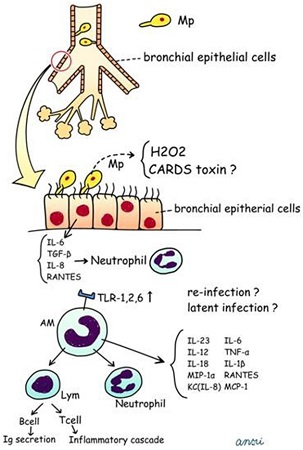Summary
Definition
History and exam
Key diagnostic factors
- presença de fatores de risco
- tosse persistente
- tosse seca
- sintomas prolongados
- febre
- ruídos adventícios no exame físico
- exposição a uma pessoa com infecção do trato respiratório
Other diagnostic factors
- comprometimento da garganta
- erupção cutânea
- cefaleia
- miringite bolhosa
- hepatite
Risk factors
- cenários comunitários de contato próximo
- exposição recente
- tabagismo
- idade <30 anos
- imunossupressão
- asplenia
Diagnostic investigations
1st investigations to order
- contagem leucocitária
- hemoglobina
- TFHs
- oximetria de pulso
- ureia e eletrólitos
- proteína C-reativa
- radiografia torácica
Investigations to consider
- teste de amplificação de ácido nucleico (NAAT)
- sorologia
- cultura±/coloração de Gram
Emerging tests
- teste de antígenos
Treatment algorithm
com pneumonia
Contributors
Authors
Ran Nir-Paz, MD

Professor in Medicine and Clinical Microbiology
Department of Clinical Microbiology and Infectious Diseases
Hadassah-Hebrew University Medical Center
Jerusalem
Israel
Disclosures
RNP declares that he has no competing interests. RNP is an author of several references cited in this topic.
Takeshi Saraya, MD, PhD
Associate Professor
Department of Respiratory Medicine
Kyorin University School of Medicine
Tokyo
Japan
Declarações
TS declares that he has no competing interests.
Revisores
Enno Jacobs, MD
Director
Institute for Medical Microbiology and Hygiene
Dresden
Germany
Declarações
EJ declares that he has no competing interests.
Laura J. Christie, MD
Research Scientist
Pediatric Infectious Disease
California Department of Public Health
Viral and Rickettsial Disease Laboratory
Richmond
CA
Declarações
LC declares that she has no competing interests.
Créditos aos pareceristas
Os tópicos do BMJ Best Practice são constantemente atualizados, seguindo os desenvolvimentos das evidências e das diretrizes. Os pareceristas aqui listados revisaram o conteúdo pelo menos uma vez durante a história do tópico.
Declarações
As afiliações e declarações dos pareceristas referem--se ao momento da revisão.
Referências
Principais artigos
British Thoracic Society. BTS guidelines for the management of community acquired pneumonia in adults: update 2009. Jan 2015 [internet publication].Texto completo
Metlay JP, Waterer GW, Long AC, et al. Diagnosis and treatment of adults with community-acquired pneumonia. An official clinical practice guideline of the American Thoracic Society and Infectious Diseases Society of America. Am J Respir Crit Care Med. 2019 Oct 1;200(7):e45-67.Texto completo Resumo
Artigos de referência
Uma lista completa das fontes referenciadas neste tópico está disponível para os usuários com acesso total ao BMJ Best Practice.

Diagnósticos diferenciais
- Doença do coronavírus 2019 (COVID-19)
- Pneumonia bacteriana típica
- Pneumonia viral
Mais Diagnósticos diferenciaisDiretrizes
- Diagnosis and treatment of adults with community-acquired pneumonia
- Pneumonia (community-acquired): antimicrobial prescribing
Mais DiretrizesFolhetos informativos para os pacientes
Pneumonia
Pneumonia: preciso de vacina?
Mais Folhetos informativos para os pacientesCalculadoras
Escore CURB-65 de gravidade de uma pneumonia.
Índice de gravidade de pneumonia adquirida na Comunidade (PSI) para adultos
Mais CalculadorasConectar-se ou assinar para acessar todo o BMJ Best Practice
O uso deste conteúdo está sujeito ao nosso aviso legal